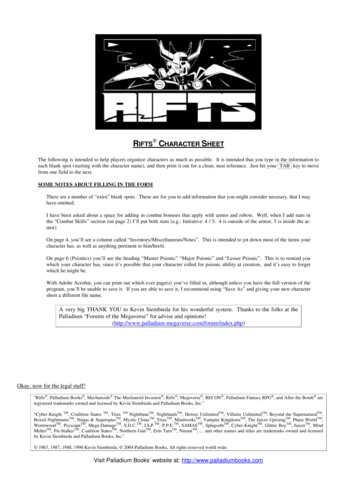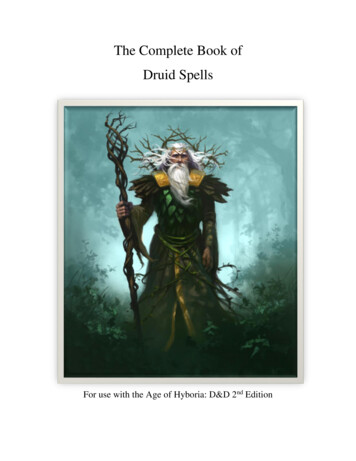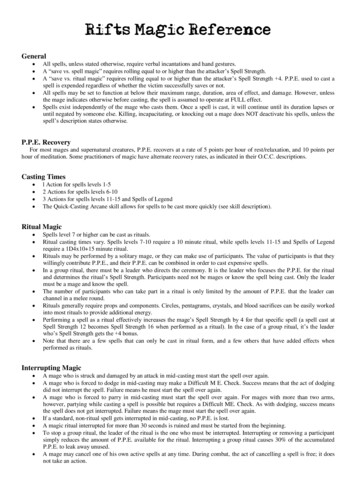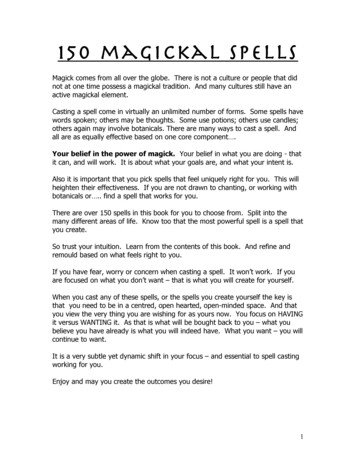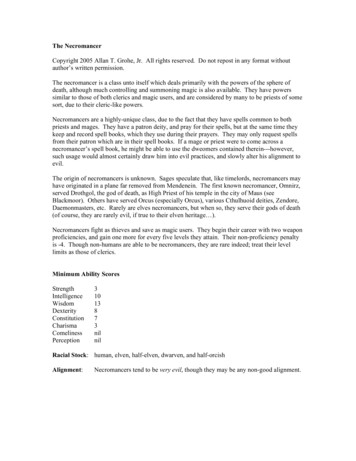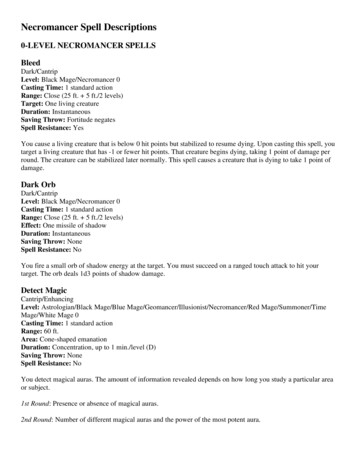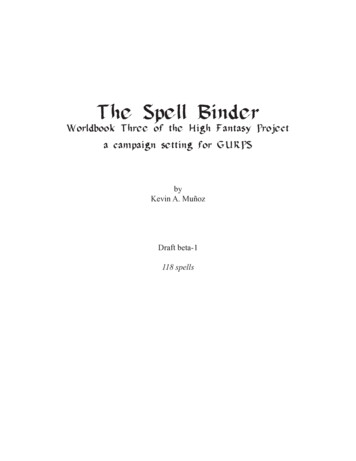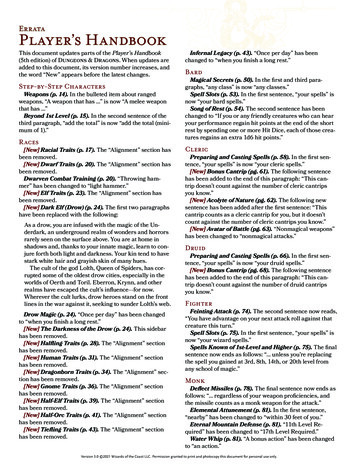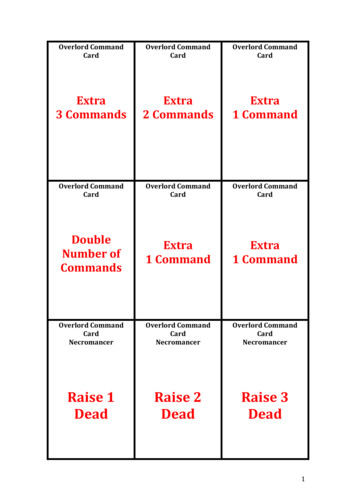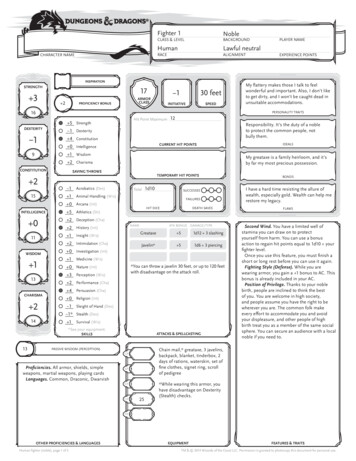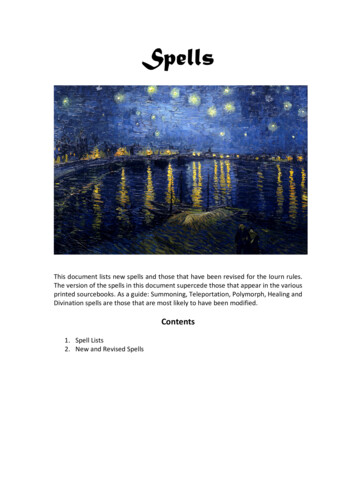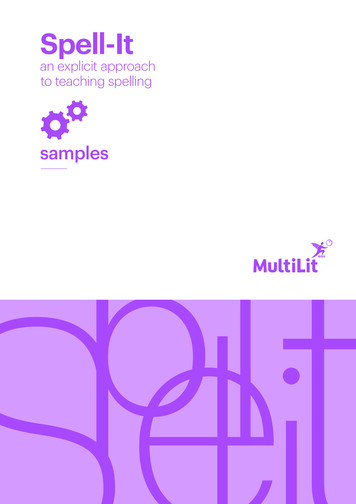
Transcription
Spell-Itan explicit approachto teaching spellingsamples
Spell-ItProgram ContentSpell-It provides an explicit and structured approach to teaching spelling within a whole-class or small groupframework. The program provides assessment tools for teachers to identify the spelling skills that areneeded most, and to develop a teaching program to target these areas.Specific teaching strategies are included for each teaching topic, with alternative ‘routes’ for differentiatedinstruction, extensive examples and word lists for use within lessons.The program’s content can be delivered over time, and through practical activities and targeted writtenexercises, students’ ability to generalise their newly learned spelling skills to their writing can be monitored.The Spell–It Kit includes: Teacher Manual, including assessment tools 2 Teaching Topic Manuals, covering 17 topics dealing with a variety of spelling patterns and concepts Sample Student Activity Book Answer Book My Spelling Dictionary Access to online resources to be used alongside the lessons. Additional Student Activity Books (which are also available as a downloadable) can be purchasedseparately from MultiLit.Spell–It Cards: The cards used alongside the program can either be downloaded from the MultiLit Members’Area, or purchased as a set from the MultiLit website.Spell-It TopicsTopic 1Spelling the Sounds of Australian EnglishExercises 1 – 2Topic 10Root WordsExercises 154 – 168Topic 2BlendsExercises 3 – 11Topic 11PrefixesExercises 169 – 180Topic 3‘h’ Digraph Spelling PatternsExercises 12 – 17Topic 12SuffixesExercises 181 – 197Topic 4Short Vowel SoundsExercises 18 – 23Topic 13PluralsExercises 198 – 202Topic 5The Role of the Final ‘e’Exercises 24 – 25Topic 14Compound WordsExercises 203 – 209Topic 6Long Vowel SoundsExercises 26 – 53Topic 15Homonyms, Homophones and HomographsExercise 210Topic 7Other Vowel SoundsExercises 54 – 89Topic 16ContractionsExercises 211 – 219Topic 8Consonant Sounds Spelled in Diverse WaysExercises 90 – 124Topic 17Possessive ApostrophesExercises 220 – 226Topic 9SyllablesExercises 125 – 153
Purpose of Spell-It To guide the provision of a targeted Tier 1 (whole class) or Tier 2 (small group) spellingprogram for older, inaccurate spellers. To provide teachers with information about the English spelling system.How to Use Spell-ItRead Chapter 1: Spelling MethodologyThis explains the philosophy and research base that underpins the approach to teaching spellingin Spell-It.Read Chapter 2: AssessmentSelect appropriate Gap Analysis Assessment and administer. Follow the flow chart in the Manualto analyse results and to decide if students need further assessment. Select appropriateteaching method – Thorough Route or Quick Route.Group students if necessary for differentiated instruction.Select Teaching TopicPlan spelling instruction for the year, term and week.Planning Models available in the Manual for suggestions for weekly spelling instruction.Select Practice ActivitiesChoose appropriate practice activities from the Activity Book as necessary – they may vary fordifferent groups of students. Refer to the summary of Topics and Practice Exercises at thebeginning of each Teaching Manual to find the practice activities that relate to each teachingtopic.Practice activities may be completed at school or as part of a weekly homework program.Read Chapter 3: ApplyingSpelling Knowledge to WritingPlan a weekly proofreading/editing program.Choose weekly words to develop spelling memory and/or vocabulary knowledge. Refer to MySpelling Dictionary for appropriate words. Proofreading goals and word lists can vary accordingto the needs of the individual students or groups of students.Regularly monitor students’spelling progressUse students’ daily writing, 15-minute writing samples, proofreading programs and Gap AnalysisAssessments to decide if students understand the principles that underpin the spelling system ofEnglish, and if they are able to transfer this knowledge to their writing. Adjust instruction accordingly.
Spell-ItDownloadableGap Analysis Assessment2 Analysis Assessment 2– GapDownloadableAdministration and Marking GuideNote: This is a snapshot only – this is not the complete document.!Gap Analysis Assessment 2Administration and Marking GuideAll words should be spelled completely correctly to be marked right, even if the part of the word thatis incorrect is not the target being assessed. For example: the student writes ‘thinnist’ for ‘thinnest’.The target (doubling the consonant before the suffix) is correct but the suffix ‘est’ has been spelled‘ist’. Mark as incorrect and make a note that the error relates to the spelling of the suffix, not to theapplication of the rule.Part AFor each of the items below, read out the word that is to be spelled and the sentence beside it.Students record the words on their Recording Sheet.Adding suffixes to words that have a long or short vowel sound in the last syllable12345678gliding: I watched the hawk gliding overhead.thinnest: This is the thinnest piece of string I could find.riding: I like riding my bike around the park.baked: My brother baked a banana cake after school.bitten: I was bitten by a spider.jogger: The jogger was exhausted by the time he had run around the bays.winning: My sister shot the winning goal in the netball tournament.fanned: It was so hot at the concert that we fanned ourselves with our programs./8Adding suffixes to words that end in ‘y’9101112131415countries: Many countries take part in the Olympic Games.scariest: It was the scariest movie I had ever seen.marrying: My brother is marrying my best friend tomorrow.worried: I am worried about being late for my job interview.prettiest: She was the prettiest baby in the room.carrier: The mosquito is a carrier of disease.buried: The dog buried its bone under a tree./7!!Words ending in /k/16 slick: There was a big oil slick after the ship was wrecked.17 revoke: The council can revoke a trader’s licence if the trader breaks the rules.1
Part BStudents follow instructions on their Recording Sheet and record their answers.PluralsGive one mark for each correct word. If an apostrophe has been added, the word is es/10ContractionsGive one mark for each correct word. The apostrophe must be in the correct place.Expanded formContractionExpanded formContractionthere isthere’swhere iswhere’sshould notshouldn’twill notwon’tI’dcould notcouldn’twe wouldwe’dthey arethey’reI wouldSpell-Ityou areI haveDownloadableGap Analysisyou’reAssessment 2Administration and Marking GuideI’ve/10!!!Part CStudents follow instructions on their Recording Sheet and record their answers.ProofreadingGive one mark for finding the error and one mark for correcting it. If an error has been rewrittencorrectly (even if it is not underlined) give two marks. If an error is underlined but has not beenrewritten correctly, give one mark.The Olympick Games are held every four years.OlympicAthletes from arownd the world compete witharoundeach other to win a medal. Everyone wishs forwishesa gold but even to go to the games is a grate achievement.greatThere is alot of work to do before the games are helda lotand the host citys spend years preparing for them.citiesIts always exciting to find out who will host theIt’snext Games. Countrys wanting to host the GamesCountrieschoose a city and send a proposal about their citys plans.city’s3!
Teaching TopicsNote: This is a snapshot only – this is not the complete document.Topic 7Other Vowel SoundsSpelling choices for the /ar/ soundSpelling choices for the /er/ soundSpelling choices for the /or/ soundSpelling choices for the /ear/ and /air/ soundsSpelling choices for the /ow/ soundSpelling choices for the /oy/ sound7!
Many words that contain /oyl/ use ‘oi’, even if the sound is at the end of a syllable (e.g., toi/let).Sometimes, one-syllable /oyl/ words are pronounced as if they have two syllables, which makes the/oy/ sound appear to be at the end of a syllable (e.g., boil, coil, toil, foil, spoil).A few other words also use ‘oi’ at the end of a syllable (e.g., loi/ter, goi/tre, em/broi/der).Goals and ProcedureStudents will learn:Teaching Topic 7Spell-ItOther Vowel Sounds to identify these vowel sounds in words – /ar/, /er/, /or/, /ear/, /air/, /ow/, /oy/;to recognise the different spelling patterns for these vowel sounds;to spell these vowel sounds in various ways;the conventions that influence the spelling of these vowel sounds.!!!149Note: The pronunciation of these vowel sounds can vary. You may need to substitute the examplesused in this topic with other words to suit your local accent (e.g., ‘dance’, ‘castle’ – these words maybe pronounced with an /ar/ or /a/ sound; ‘data’ – this word may be pronounced with an /ar/ sound or/ai/ sound depending on accent variation).The /ar/ soundQuick RouteMaterials Activity Book: Exercises 1, 54-55Exercise BooksWhiteboardThe /ar/ sound is most commonly written ‘ar’ but in Australian English pronunciation, the ‘a’ in somewords like ‘basket’, ‘past’, ‘path’ is also pronounced /ar/.Ask students to complete the parts of Exercise 1 in the Activity Book that relate to the /ar/ sound.They should find the spelling patterns for this sound. They can then brainstorm words that use thesepatterns to complete this statement:The /ar/ sound can be written in the following ways: ar – army, farm, car a – fast, path al – half, calf, calm ear – heart, hearthStudents can complete Exercises 54-55 in the Activity Book, if they need practice working with the/ar/ sound.!!150
Thorough RouteMaterials Activity Book: Exercises 1, 56-58Exercise BooksWhiteboardComplete the following activities as needed, then work through the Quick Route for this sound asdescribed above.Elkonin Boxes1Call out each word in the list below.2Students count the number of sounds in the word.3Students draw the correct number of sound boxes for each word in their exercise books.4Write the spelling of the words on the whiteboard.5Ask students to fill in each sound box with the letters representing each sound.6Students circle the /ar/ sound box in each word and write down the different spellingpatterns they have found in the list.7Students can then complete the part of Exercise 1 in the Activity Book that relates to the /ar/sound.largelargemarginmargcalmcalmin!!!151
theartDictationDictationIf more practice is needed, complete some of these dictation exercises.If more practice is needed, complete some of these dictation exercises.Read the following dictation sentences to students. Write the correct sentence on the whiteboard forstudents to mark their own work. Ask students to underline all the words that have an /ar/ sound andRead the following dictation sentences to students. Write the correct sentence on the whiteboard forthen circle the spelling pattern for the /ar/ sound (as bolded below). Choose dictation sentences thatstudents to mark their own work. Ask students to underline all the words that have an /ar/ sound andare appropriate for your students – you do not need to do them all.then circle the spelling pattern for the /ar/ sound (as bolded below). Choose dictation sentences thatare appropriate for your students – you do not need to do them all.Spell-ItTeaching Topic 7Short dictationsOther Vowel SoundsShort dictations1 I parked my car by the gardens and went for a walk in the park.12I parked my car by the gardens and went for a walk in the park.The calf ran past the farmer and into the raspberry bushes.2 The Teachingcalf ranTopicpast the farmer and into the raspberry bushes.Spell-It3 I droppedthe jar7of marmalade on the hard stone floor and it smashed.Other Vowel Sounds!! 3 I dropped the jar of marmalade on the hard stone floor and it smashed.4 I can see a large star sparkling in the dark night.enjoy4!I can see a large star sparkling in the dark night.The /oy/ sound is at the end of a word so it will be spelled ‘oy’.LongerdictationsOne point for using ‘oy’ in the word ‘enjoy’ – ‘e’ ‘n’ ‘j’ ‘oy’. (Write the word on the whiteboardas you spell it.)Longer dictations1 The army marched for days before it reached the castle. Although everyone was tired, voyagethey were going to charge the main gate at the start of the next day.1 The army marched for days before it reached the castle. Although everyone was tired,theywere goingtoonchargethesomaingateat the startof the next day.The /oy/at the endofaamarblesyllableit willbe spelled2Mysoundfatherisslippedandspilta glass‘oy’.of wine and a bottle of tomato sauce. NoOne point for using ‘oy’ in the word ‘voyage’ – ‘v’ ‘oy’ ‘a’ ‘ge’. (Write the word on thematter how hard he rubbed, he could not get the marks off the carpet.whiteboard as you spell it.)!!Spell-ItTeaching Topic 73 In87-89MarchweActivityharvesteda basketfull e Exercisesin theBook forextra practicewithfromthe /oy/in words.1524 The shark is a master hunter. It charges at its target and kills it with its sharp teeth.152 developmentVocabulary5The farmer left the gate of his garden ajar and a calf got in and ate half of the newYou could usetomatoes.any of the following words for vocabulary development. Students could find themeanings of the words and use them in sentences. Try to find opportunities during the week to use/oy/ words in different curriculum areas.Students can complete Exercises 56-58 in the Activity Book if they need more practice working withthe eeenjoy2 My father slippedon a marble andspilt a glass of wineand a bottle of tomato sauce. Noloyalvoyageappointavoidmatter how hard he rubbed, he could not get the marks off the ist3a basketpointfull of tomatoes fromour garden.noiseIn March we harvestedoilpoisonspoiltoilvoicevoidThe /er/ soundQuickRoute4 The shark is a master hunter. It charges at its target and kills it with its sharp teeth.!!Materials5 The farmer left the gate of his garden ajar and a calf got in and ate half of the newtomatoes. Activity Book: Exercises 1, 59-61 Exercise BooksStudents can complete Exercises 56-58 in the Activity Book if they need more practice working with Whiteboardthe /ar/ sound.Ask students to complete the parts of Exercise 1 in the Activity Book that relate to the /er/ sound, tofind the spelling patterns for this sound. They can then brainstorm words that use these patterns tocomplete this statement:The /er/ sound!!QuickTheRoute/er/ sound can be written in the following ways:Materials er – her, person176 ir – stir, thirty Activity Book: Exercises 1, 59-61 ur – turtle,furExerciseBooks urr – purr, furryWhiteboard ear – early, learnAsk students to complete the parts of Exercise 1 in the Activity Book that relate to the /er/ sound, to or – work, wordfind the spelling patterns for this sound. They can then brainstorm words that use these patterns tocomplete this statement:!
Activity BookSpell-ItActivity BookTopic 7 – Other Vowel SoundsNote: This is a snapshot only – this is not the complete document.Topic 7 – Other Vowel SoundsExercise 56Use these two common /ar/ spelling patterns to build words with letters from the box.stpcarahmflrkExample: star, tar, fastSpell-ItActivity BookTopic 7 – Other Vowel Sounds!!!Exercise 57Complete the following sentences with a word that contains an /ar/ sound. The first (or last)letter has been given as a hint. Circle the /ar/ spelling patterns. The first one has been doneas an example.1.You can still see the sc ar on my arm from where I had stitches.2.Mum left me in cshops.3.Themy museum of Western Australia has tanks and guns around theoutside.4.I only have h1205.!!The ffence.of my younger brothers while she went to thea teaspoon of sugar in my tea.was furious when the sheep escaped through a hole in the6.Moranges.7.Ships’ captains used to use ch8.He was the s9.The little girl was dressed as a fairy and her wand sis a special kind of jam that can be made from grapefruit orto navigate the oceans.of the show.10. I couldn’t wait to open the pin the light.that was delivered by the courier.!
Exercise 58Fill in the spelling patterns for each sound in these words. Circle the boxes that contain the/ar/ sound. The first one has been done as an example.farmerfarmercartonheartgardenvase!My Spelling Dictionary – optional consumableThe My Spelling dictionary provides students with lists of words organised by beginningsound, rather than letter (highlighting the varying spelling patterns for that sound), withroom for students to add words they encounter in their reading and writing to each list.The dictionary also includes reference sections summarising English spelling rules, andlisting common prefixes, suffixes and useful word roots. One teacher copy of thedictionary is provided in the Spell-It Kit. Additional dictionaries will need to be purchasedshould schools wish to have one copy for every student in the class or group. Additionalcopies can be purchased from the MultiLit website. Subject to wear and tear, studentsshould only require one copy of the My Spelling Dictionary.
MUL0021 SpellingDictionaryArtwork FA 03.indd somealwaysalthoughalsoalreadyalmostWords for writingWords beginning with /or/oremoreorfor/or/ can look like uryourourtaughtcaughtaughsoughtfoughtoughOther /or/ wordsautomaticallyauthorityauthoralternativeCommon academic wordsDefinitionDefinition23/11/12 12:36 PM35/or/My Spelling Dictionary cont.Note: This is a snapshot only – this is not the complete document.!
Downloadables – Spell-It CardsNote: This is a snapshot only – this is not the complete document.!Spell-ItDownloadableTopic 7 – Other Vowel SoundsOther Vowel Sounds Word Cards /air/ and /ear/ (Set tSpell-It!pearSpell-It!
Spell-Itan explicit approachto teaching spellingFind out moreFor further information on Spell-It, visit the MultiLitwebsite or contact sales@multilit.com.Publication and Professional Developmentworkshop orders can be placed online at theMultiLit Shop. www.multilit.com
The /ar/ sound is most commonly written ‘ar’ but in Australian English pronunciation, the ‘a’ in some words like ‘basket’, ‘past’, ‘path’ is also pronounced /ar/. Ask students to complete the parts of Exercise 1 in the Activity Book that relate to the /ar/ sound. They should !
